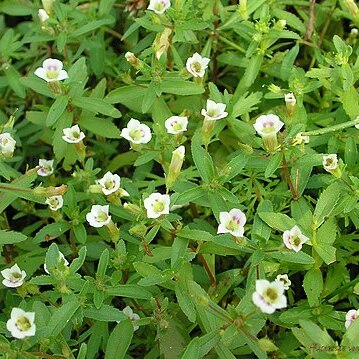Calyx minutely pubescent to subglabrous; lateral sepals c. 3.5 mm. long, 1–1.5 mm. wide, lanceolate, midrib somewhat keeled, shortly hispid; posterior 6.5 x 6 mm., broadly ovate; anterior c. 6–6.4 x 4.3–5 mm., broadly ovate, all segments prominently nerved though laterals less so.
Erect or ascending herb, up to 450 mm tall. Leaves narrowly ovate, narrowed to base or sessile, 10-35 x 3-6(-15) mm, pubescent. Pedicels pubescent, 5-11 mm long. Largest calyx segment broadly ovate, 8 x 7 mm in fruit, pubescent. Flowers mauve.
Leaves (10)15–24(40) x (1.5)2–5 mm., sessile, linear to linear-lanceolate, barely acute, narrowed shortly or at length to subamplexicaul base, entire, shortly scabrid to subglabrous, glandular-punctate beneath.
Erect, slender herb 8–14(35) cm. tall, scabrid, pubescent to subglabrous; stem simple to more frequently much branched, terete to channelled above, tetragonal below, occasionally subulate towards base.
Flowers axillary, usually solitary, white, through pink to blue or violet, pedicellate, bibracteate.
Corolla 4–6 mm. long; upper lip c. 2 mm. wide, emarginate; lower lip 3-lobed, lobes equal.
Bracts 1–1.5 mm. long, setaceous, subpatent, arising c. 0.5 mm. below base of calyx.
Capsule 3–3.25 mm. long, 2.5 mm. in diam., somewhat flattened-ellipsoid, glabrous.
Erect or ascending variable herb, 3-18 in. high flowers mauve
Pedicels (2)4–5 mm. long, hispid.


